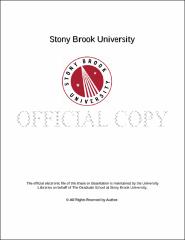| dc.identifier.uri | http://hdl.handle.net/11401/77054 | |
| dc.description.sponsorship | This work is sponsored by the Stony Brook University Graduate School in compliance with the requirements for completion of degree. | en_US |
| dc.format | Monograph | |
| dc.format.medium | Electronic Resource | en_US |
| dc.language.iso | en_US | |
| dc.publisher | The Graduate School, Stony Brook University: Stony Brook, NY. | |
| dc.type | Dissertation | |
| dcterms.abstract | Precisely defined and multifunctional molecular architectures that can form liquid crystalline mesophases are part of a new generation of functional supramolecular materials. Liquid crystalline compounds (mesogens) form phases of matter intermediate between crystalline solids and isotropic liquids (mesophases). The presence of molecular order in a fluid phase has led to the widespread use of conventional liquid crystal mesogens in displays and optoelectronic devices. Combining different types of mesogens or mesogens with other functional components to create heterolithic star-branched or dendritic architectures is of interest as a strategy to engineer liquid crystalline materials with new structural and functional properties. Heterolithic branched molecular architectures are difficult to synthesize, and so very little is known about the properties of heterolithic star-branched or dendritic mesogens. This thesis demonstrates that highly convergent synthesis strategies based on multicomponent reactions can accelerate the synthesis of heterolithic branched compounds. We employed the Passerini three-component reaction in the most convergent synthesis of a star-branched mesogen in which each arm is composed of a different calamitic mesogen and flexible linker (i.e., an ABC star-branched mesogen). The ABC star-branched mesogen forms a mesophase that is more ordered than the mesophases observed in more symmetric star-branched mesogens. The modularity of the Passerini reaction was exploited to prepare focused libraries of mesogens. Differential scanning calorimetry (DSC), polarized optical microscopy (POM), and X-ray diffraction (XRD) experiments with materials from these focused libraries established how each arm contributes to the phase behavior of the ABC star-branched mesogens. Analysis of the DSC data confirmed the limited stability of the mesophases formed by the ABC star-branched mesogens. Higher molecular weight analogs of the ABC star-branched mesogens (i.e., triblock dendrimers) are expected to improve the stability of the mesophase. Kinetic studies of model Passerini reactions identified an electronic effect that accelerates the reaction, and this enhanced reactivity has enabled the synthesis of three generations of dendrimers via the Passerini three-component reaction. This work has demonstrated a rapid approach to synthesize heterolithic star-branched mesogens and the feasibility to prepare multifunctional dendritic mesogens via the Passerini reaction. | |
| dcterms.available | 2017-09-20T16:51:48Z | |
| dcterms.contributor | Parker, Kathlyn | en_US |
| dcterms.contributor | Rudick, Jonathan G. | en_US |
| dcterms.contributor | Aubrecht, Katherine | en_US |
| dcterms.contributor | Yager, Kevin. | en_US |
| dcterms.creator | Song, Shuang | |
| dcterms.dateAccepted | 2017-09-20T16:51:48Z | |
| dcterms.dateSubmitted | 2017-09-20T16:51:48Z | |
| dcterms.description | Department of Chemistry | en_US |
| dcterms.extent | 147 pg. | en_US |
| dcterms.format | Monograph | |
| dcterms.format | Application/PDF | en_US |
| dcterms.identifier | http://hdl.handle.net/11401/77054 | |
| dcterms.issued | 2016-12-01 | |
| dcterms.language | en_US | |
| dcterms.provenance | Made available in DSpace on 2017-09-20T16:51:48Z (GMT). No. of bitstreams: 1
Song_grad.sunysb_0771E_13171.pdf: 24295433 bytes, checksum: b2a202ce4054a38f54708b4e8dd5022e (MD5)
Previous issue date: 1 | en |
| dcterms.publisher | The Graduate School, Stony Brook University: Stony Brook, NY. | |
| dcterms.subject | Chemistry | |
| dcterms.title | Heterolithic branched liquid crystalline materials prepared via the Passerini three-component reaction | |
| dcterms.type | Dissertation | |


